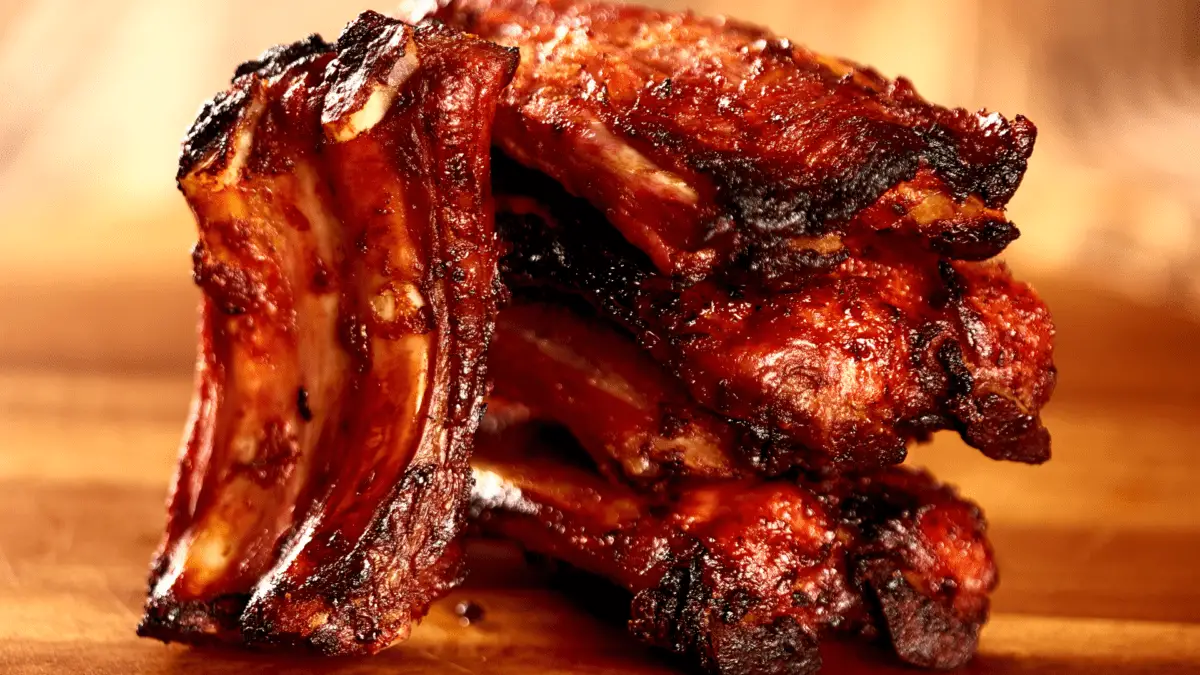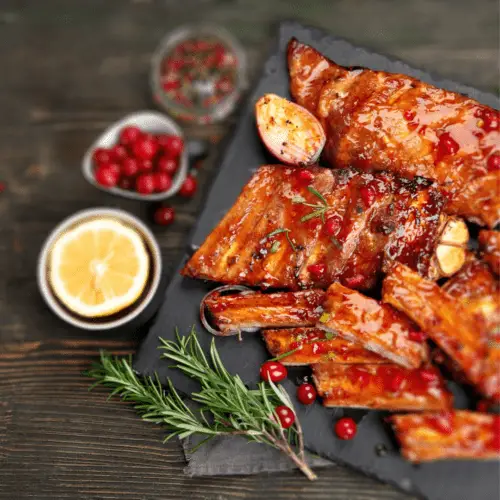Sake-Marinated Beef Ribs Recipe You Don’t Want to Miss
Beef short ribs are a BBQ favorite – but what about roasting them in a juicy marinade?
Sake-marinated beef ribs are one of the most flavorful foods in Japan. The meat is so tender that it’s almost like eating a piece of steak.
Beef ribs have a rich, savory flavor that pairs perfectly with the light sweetness of sake.
Maybe you’ve tried Korean-style galbi before, but the lighter sake marinade used by Japanese cooks is a different take on that classic recipe.
If you’ve never tried sake-marinated beef ribs, you’re missing out!


Check out our new cookbook
Bitemybun's family recipes with complete meal planner and recipe guide.
Try it out for free with Kindle Unlimited:
Read for freeIn this post we'll cover:
Cooking Japanese sake-marinated beef ribs at home
In this recipe, we’ll show you how to make this delicious dish at home.

Sake-Marinated Beef Ribs
Ingredients
- 8 pounds meaty beef short ribs cut crosswise into 2-inch lengths
- 3 cups sake rice wine
- 2 large onions thinly sliced
- 2 medium carrots finely chopped
- 1 celery rib finely chopped
- 24 green olives pitted
- 1 tbsp ground coriander
- 1 tsp minced garlic
- 1 tsp finely grated ginger
- 1 tsp ground turmeric
- 1 tsp curry powder
- 1/2 tsp cayenne pepper
- 1 pinch saffron threads
- salt and freshly ground white pepper
- 2 cups short-grain rice about 14 ounces
- 2 tbsp soy sauce Optional
- 2 tbsp chopped flat-leaf parsley
Instructions
- Spread the ribs in an even layer in a large glass or ceramic baking dish. Pour 2 cups of the sake over the ribs, cover, and let marinate overnight in the refrigerator.
- Preheat the oven to 350°.
- Drain the ribs. In a large roasting pan, toss the ribs with the onions, carrots, celery, olives, coriander, garlic, ginger, turmeric, curry powder, cayenne, saffron, and the remaining 1 cup of sake; season with salt and white pepper.
- Cover with foil and roast, turning the ribs halfway through cooking for about 3 hours or until the meat is very tender; skim the fat occasionally. Season with salt and pepper.
- Meanwhile, bring a large saucepan of salted water to a boil. Add the rice and boil over moderate heat until tender, about 17 minutes.
- Drain the rice and return it to the saucepan. Stir in the soy sauce.
- Spoon the rice into 4 bowls. Spoon the short ribs and sauce over the rice, garnish with the parsley and serve.
Cooking tips
- Ask your butcher to give you the ribs that are cut across the bone, and let them marinate overnight to absorb the flavors.
- Although the process is straightforward, the longer you let the short ribs marinate, the better they’ll taste. It is best to let short ribs marinate in a moist mixture of soy sauce, sake, and a blend of spices for at least 8 hours prior to roasting. The sake tenderizes the meat.
- Experiment with different types of soy sauce and spices to create your own perfect marinade.
- If you prefer a sweeter or spicier flavor, add sugar or chili flakes to the marinade.
- To get even more flavor out of your beef ribs, roast them in a smoker or charcoal grill for a smoky, charred flavor.
- It’s important to turn the ribs halfway through the cooking process to ensure that both sides are evenly browned and cooked. If you want to add a bit more color, finish the ribs off under the broiler.
Substitutes and variations
For this recipe, you can use regular soy sauce. But, the meat will turn more crimson and have a stronger savory flavor if you use dark soy sauce.
Use a little more of the light soy, which is the sort that is most frequently found in grocery stores, if you only have access to that.
You can also use a combination of sake and mirin to marinate your beef ribs.
This sweet and tangy combination helps to add a touch of richness to the meat, while also helping to tenderize it.
For the spice mix, I used curry, coriander, garlic, turmeric, saffron, ginger, and pepper. However, you can use other spices to create your own version of this dish.
I also recommend Japanese seven spice which is a bit spicy but very bold.
The most popular variation of this recipe is Korean beef ribs, also called galbi.
To make a Korean-style marinade, use soy sauce, fruit, ginger, garlic, chili flakes or powder, and sesame oil. The sauce is sweeter than Japan’s sake version.
Find out what exactly are the differences between Korean BBQ and Japanese BBQ
How to serve and eat
We recommend serving the beef ribs cut across the bone since they are more manageable pieces that way.
These are perfect for sharing, so you can enjoy them with a group at your next dinner party or gathering.
To eat the beef ribs, simply use a knife and fork to cut off bite-sized pieces. You can also use your hands to eat off the bone.
Serve alongside rice and coleslaw for an authentic BBQ experience. Steamed vegetables are also a good side dish option.
Some people also like to serve the ribs with pickled daikon radish or chili sauce on the side for an extra kick of flavor.
The dry but sweet sake marinade calls for a soft, generous red wine without too much tannin.
How to store leftovers
If you have any leftover beef ribs, store them in an airtight container in the refrigerator for up to 3 days.
Reheat gently on the stovetop or in the microwave, adding a little bit of water or broth if needed to keep the ribs moist.
You can also freeze the beef ribs for up to 3 months. Thaw before reheating, and make sure you do so slowly and gently in order to prevent drying out the meat.
To use the leftover marinade, simply strain out any bits of spice and fat, then refrigerate or freeze.
Similar dishes
As I previously mentioned, these sake-marinated short ribs are similar to the Korean glazed galbi short ribs, but those are sweeter.
The Japanese also have other sake-marinated yakiniku (or BBQ meats) like beef tongue, chicken thighs, and pork belly.
Sake-marinated pork is a common dish too. In fact, many people enjoy sake and sugar pulled pork which can be served with rice, potato fries, or in a burger.
A sake marinade is also used in Western dishes like beef stew and stir-fry.
If you have any leftovers, try adding the marinade to your next batch of fried rice, or use it as a base for soup stock.
If you’re looking for something a bit different, try making beer-marinated short ribs instead.
In this recipe, you marinate the short ribs in a lager or pale ale, along with some white or red wine vinegar.
Conclusion
When you’re looking for a savory and umami meat recipe, these marinated and oven-roasted beef short ribs are the perfect meal option.
With a combination of soft sake and savory spices, these ribs are an indulgent treat that everyone will love.
They go well with all kinds of Japanese or Western side dishes, and they’re a great way to try new Asian flavors.
After all, umami foods are popular for a good reason – they’re extremely delicious!
Wondering what sake to use for this recipe? These are the best sake choices for cooking and drinking
Check out our new cookbook
Bitemybun's family recipes with complete meal planner and recipe guide.
Try it out for free with Kindle Unlimited:
Read for freeJoost Nusselder, the founder of Bite My Bun is a content marketer, dad and loves trying out new food with Japanese food at the heart of his passion, and together with his team he's been creating in-depth blog articles since 2016 to help loyal readers with recipes and cooking tips.
